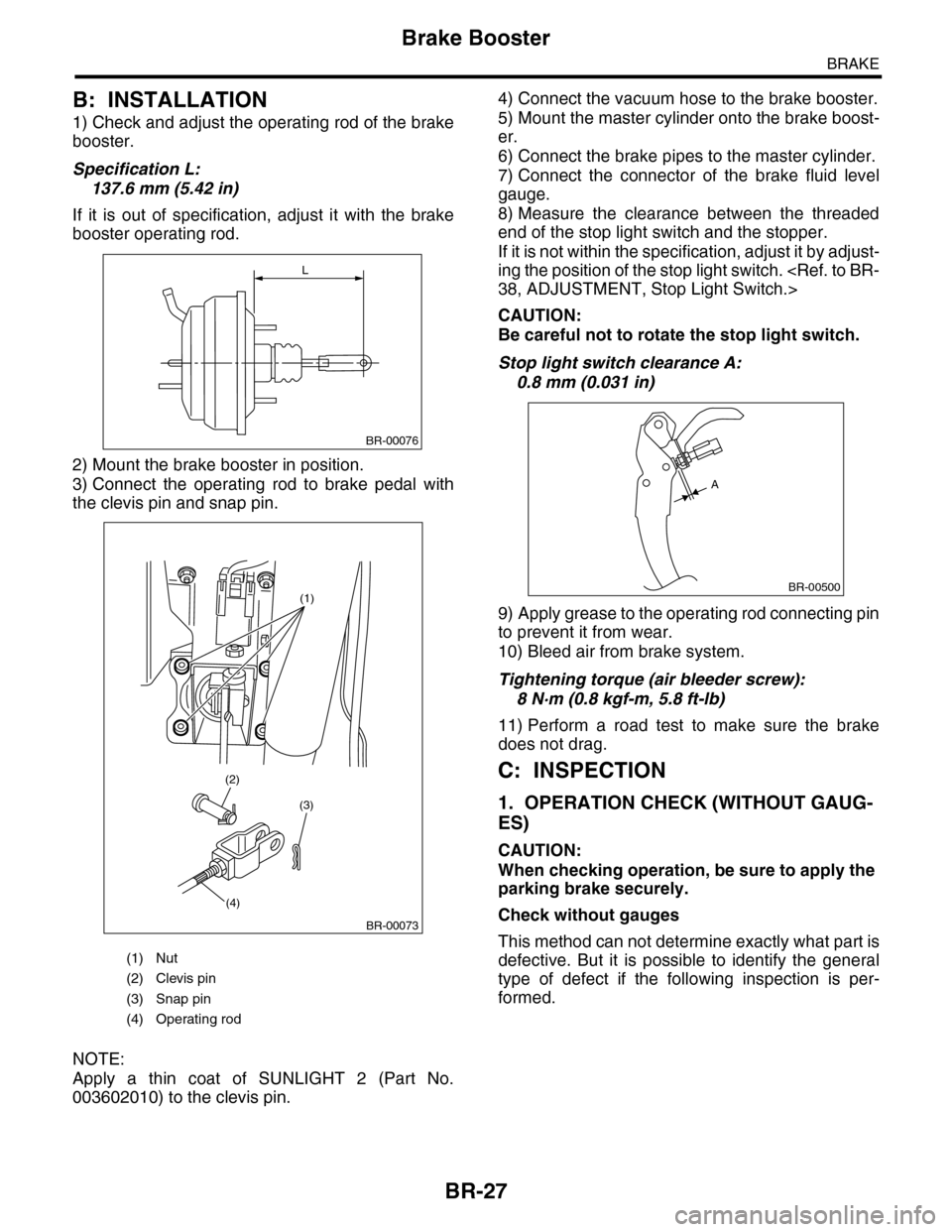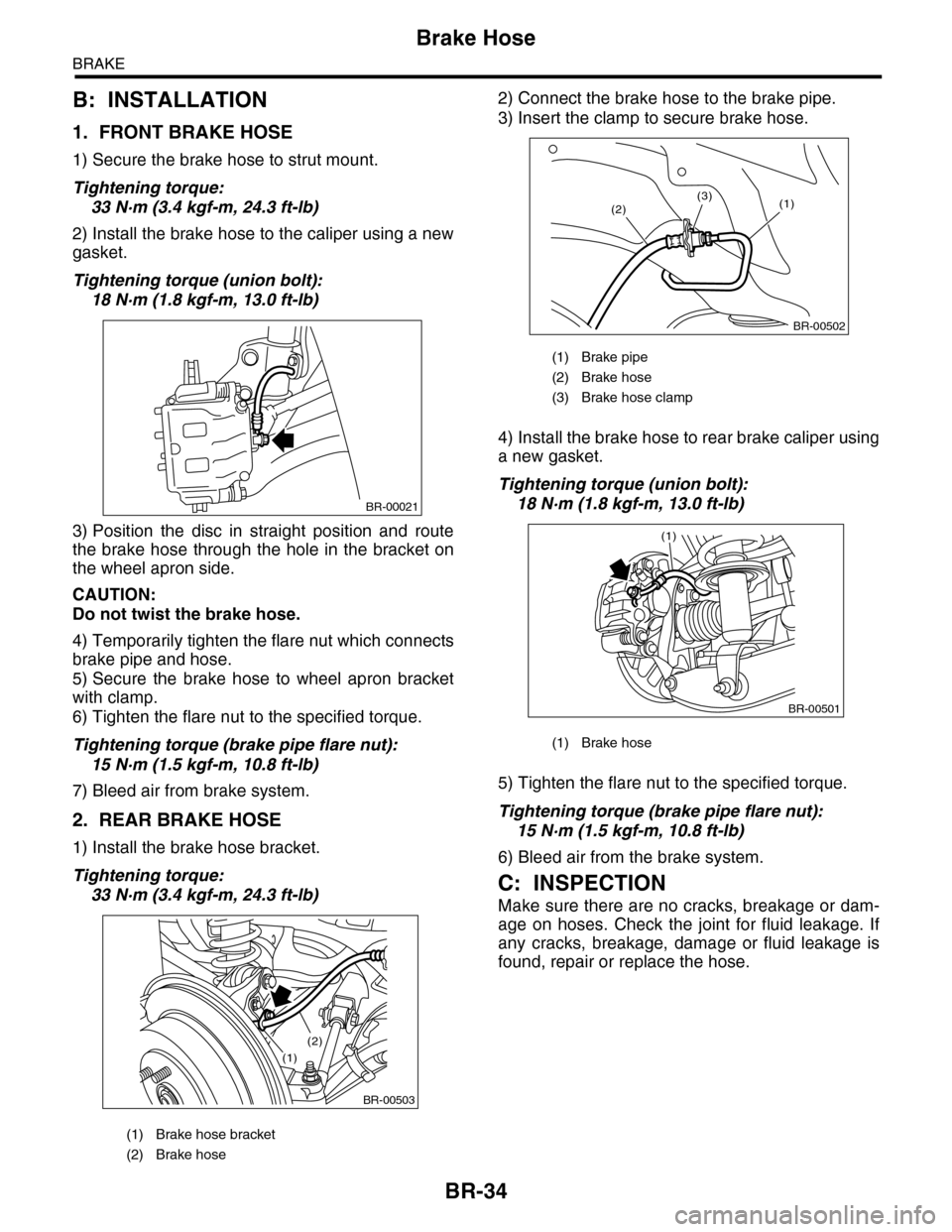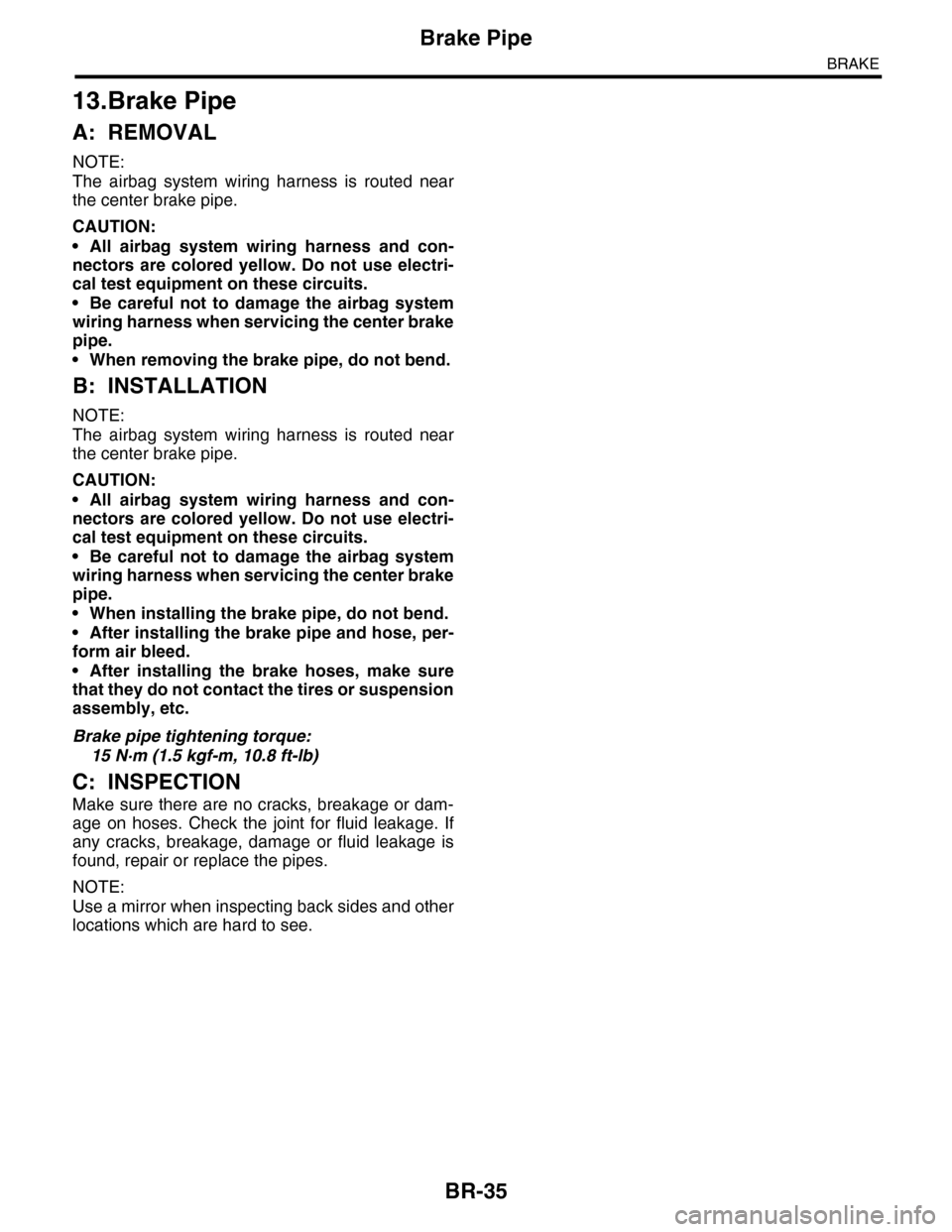2009 SUBARU TRIBECA brake fluid
[x] Cancel search: brake fluidPage 738 of 2453

BR-24
Master Cylinder
BRAKE
8. Master Cylinder
A: REMOVAL
CAUTION:
Do not allow brake fluid to come in contact with
vehicle body. If it does, wash off with water and
wipe away completely.
1) Drain brake fluid from the reservoir tank com-
pletely.
2) Disconnect the harness connector of the fluid
level gauge.
3) Remove the brake pipe from the master cylinder.
4) Remove the master cylinder mounting nuts, and
remove the master cylinder from the brake booster.
B: INSTALLATION
1) Install in the reverse order of removal.
Tightening torque:
Master cylinder mounting nut
25 N·m (2.5 kgf-m, 18.4 ft-lb)
Brake pipe
19 N·m (1.9 kgf-m, 14.0 ft-lb)
CAUTION:
Be sure to use recommended brake fluid.
2) Bleed air from brake system.
C: REPLACEMENT
1) Remove mud and dirt from the surface of brake
master cylinder.
2) Secure the master cylinder in a vise.
NOTE:
To avoid damaging the master cylinder, place be-
tween aluminum plates or other material when
holding with a vise.
3) Remove the pin which secures the master cylin-
der and reservoir tank, then remove the reservoir
tank and seal.
4) While pushing in the primary piston, remove the
C-ring using pliers.
5) While pushing in the primary piston, remove the
straight pin from the port on the reservoir tank at-
tachment location using a magnet pick-up tool.
6) Extract the primary piston assembly and sec-
ondary piston assembly straight out while taking
care not to scratch the inner surface of the cylin-
ders.
7) Clean the inside of master cylinder with brake
fluid. Check the inside of the cylinder for damage,
deformation and wear. Replace the master cylinder
as assembly if faulty.
8) Apply brake fluid to the inner surface of master
cylinder and piston assembly.
9) Make sure that the inner surface of master cylin-
der and the piston assembly are free of foreign
matter. Install the primary piston assembly and the
secondary piston assembly to master cylinder,
while taking care not to scratch the master cylinder
inner surface.
10) While pushing-in the primary piston, install the
cylinder pin.
BR-00499
(1) Straight pin
BR-00169
(1)
BR-00069
Page 741 of 2453

BR-27
Brake Booster
BRAKE
B: INSTALLATION
1) Check and adjust the operating rod of the brake
booster.
Specification L:
137.6 mm (5.42 in)
If it is out of specification, adjust it with the brake
booster operating rod.
2) Mount the brake booster in position.
3) Connect the operating rod to brake pedal with
the clevis pin and snap pin.
NOTE:
Apply a thin coat of SUNLIGHT 2 (Part No.
003602010) to the clevis pin.
4) Connect the vacuum hose to the brake booster.
5) Mount the master cylinder onto the brake boost-
er.
6) Connect the brake pipes to the master cylinder.
7) Connect the connector of the brake fluid level
gauge.
8) Measure the clearance between the threaded
end of the stop light switch and the stopper.
If it is not within the specification, adjust it by adjust-
ing the position of the stop light switch.
CAUTION:
Be careful not to rotate the stop light switch.
Stop light switch clearance A:
0.8 mm (0.031 in)
9) Apply grease to the operating rod connecting pin
to prevent it from wear.
10) Bleed air from brake system.
Tightening torque (air bleeder screw):
8 N·m (0.8 kgf-m, 5.8 ft-lb)
11) Perform a road test to make sure the brake
does not drag.
C: INSPECTION
1. OPERATION CHECK (WITHOUT GAUG-
ES)
CAUTION:
When checking operation, be sure to apply the
parking brake securely.
Check without gauges
This method can not determine exactly what part is
defective. But it is possible to identify the general
type of defect if the following inspection is per-
formed.
(1) Nut
(2) Clevis pin
(3) Snap pin
(4) Operating rod
L
BR-00076
(1)
(3)
(4)
(2)
BR-00073
BR-00500
A
Page 743 of 2453

BR-29
Brake Booster
BRAKE
Air tightness check
1) Start the engine and keep it running until vacu-
um pressure indicates point A of the vacuum gage
= 66. 7 kPa (500 mmHg, 19. 69 inHg). Do not de-
press the brake pedal at this time.
2) Stop the engine and check the gauge. If the vac-
uum pressure drop within 15 seconds after stop-
ping the engine is less than 3. 3 kPa (25 mmHg, 0.
98 inHg), the function of brake booster is normal.
If faulty, the cause may be one of the following.
•Check valve malfunction
•Leak from vacuum hose
•Leak from shell joint section or stud bolt welded
section
•Damaged diaphragm
•Leak from valve body seal and bearing section
•Leak from plate and seal assembly section
•Leak from poppet valve assembly section
Loaded air tightness check
1) Start the engine and depress the brake pedal
with a pedal force of 196 N (20 kgf, 44 lb). Keep the
engine running and keep the pedal pressed until a
vacuum of point B = 66. 7 kPa (500 mmHg, 19. 69
inHg) is indicated on the vacuum gauge.
2) Stop the engine and check the vacuum gauge.
If the vacuum pressure drop within 15 seconds af-
ter stopping the engine is less than 3.3 kPa (25
mmHg, 0.98 inHg), the function of brake booster is
normal.
If defective, refer to “AIR TIGHTNESS CHECK”.
3) If the brake booster is faulty, replace the it with a
new part.
Lack of boost action check
Turn the engine OFF, and set the value of the vac-
uum gauge to “0”. Then, check the fluid pressure
when the brake pedal is depressed. The pressure
must be greater than the specification listed.
Boosting action check
Set the vacuum gauge reading to 66. 7 kPa (500
mmHg, 19. 69 inHg) with the engine running. Then,
check the fluid pressure when the brake pedal is
depressed. The pressure must be greater than the
specification listed.
(1) Pressure gauge
(2) Vacuum gauge
(1) Pressure gauge
(2) Vacuum gauge
(3) Pedal force gauge
(4) Depressed
(1) (2)A
BR-00083
B(1) (2)
(3)
(4)
BR-00084
Brake pedal operation force
N (kgf, lb)
147
(15, 33)
294
(30, 66)
Fluid pressure
kPa (kgf/cm2, psi)
590
(6, 86)
1,654
(17, 240)
Brake pedal operation force
N (kgf, lb)
147
(15, 33)
294
(30, 66)
Fluid pressure
kPa (kgf/cm2, psi)
38,539
(87, 1,238)
15,373
(157, 2,229)
Page 744 of 2453

BR-30
Brake Fluid
BRAKE
10.Brake Fluid
A: INSPECTION
1) Check that the brake fluid level is between “MIN”
and “MAX”. If out of the specified range, refill or
drain fluid. If the fluid level is close to “MIN”, check
the brake pad for wear and refill the fluid.
2) Check the fluid for discoloration. If the fluid color
has changed excessively, drain the fluid and refill
with new fluid.
B: REPLACEMENT
CAUTION:
•Do not let brake fluid come into contact with
the painted surface of the vehicle body. Wash
away with water immediately and wipe off if it is
spilled by accident.
•Avoid mixing brake fluids of different brands
to prevent fluid performance from degrading.
•Be careful not to allow dirt or dust to enter the
reservoir tank.
NOTE:
•During the operation, keep the reservoir tank
filled with brake fluid to eliminate entry of air.
•Operate the brake pedal slowly.
•For convenience and safety, perform work with 2
people.
•The required amount of brake fluid is approxi-
mately 600 m2 (20 US fl oz, 21 Imp fl oz) for entire
brake system.
1) Lift-up the vehicle and set rigid racks at the spec-
ified locations, or keep the vehicle lifted.
2) Remove both the front and rear wheels.
3) Drain brake fluid from the reservoir tank.
4) Refill the reservoir tank with the recommended
brake fluid.
Recommended brake fluid:
Refer to the specification.
Perform the same procedure as for bleeding the
brake line, until new brake fluid comes out from vi-
nyl tube.
NOTE:
Perform the brake fluid replacement starting in or-
der from the farthest wheel cylinder from the mas-
ter cylinder.
Page 745 of 2453

BR-31
Air Bleeding
BRAKE
11.Air Bleeding
A: PROCEDURE
CAUTION:
•Do not let brake fluid come into contact with
the painted surface of the vehicle body. Wash
away with water immediately and wipe off if it is
spilled by accident.
•Avoid mixing brake fluids of different brands
to prevent fluid performance from degrading.
•Be careful not to allow dirt or dust to enter the
reservoir tank.
1. MASTER CYLINDER
NOTE:
•When the master cylinder is disassembled or the
reservoir tank is empty, bleed the master cylinder.
•If bleeding of the master cylinder is not neces-
sary, omit the following procedures, and perform
bleeding of the brake line.
1) Fill the reservoir tank of the master cylinder with
brake fluid.
NOTE:
While bleeding air, keep the reservoir tank filled
with brake fluid to prevent entry of air.
2) Disconnect the brake line at primary and sec-
ondary sides.
3) Wrap the master cylinder with a plastic bag.
4) Depress the brake pedal slowly and hold it.
5) Plug the outlet plug with your finger, and then re-
lease the brake pedal.
6) Repeat the step 4) and 5) several times.
7) Remove the plastic bag.
8) Install the brake pipe to the master cylinder.
Tightening torque:
19 N·m (1.9 kgf-m, 14.0 ft-lb)
9) Bleed air from the brake line.
2. BRAKE LINE
1) When the master cylinder is disassembled or the
reservoir tank is empty, bleed the master cylinder
before bleeding the brake line.
ing.>
2) Fill the reservoir tank of the master cylinder with
brake fluid.
NOTE:
While bleeding air, keep the reservoir tank filled
with brake fluid to prevent entry of air.
3) Attach one end of the vinyl tube to the air bleeder
and the other end to the brake fluid container.
4) Depress the brake pedal several times, and
keep it pressed.
5) Loosen the air bleeder screw to drain brake fluid.
Tighten the air bleeder quickly, and release the
brake pedal.
6) Repeat the steps 4) to 5) until there are no more
air bubbles in the vinyl tube.
7) Repeat the steps from 2) to 6) above to bleed air
from each wheel.
NOTE:
Perform the operation in the order from closest
wheel cylinder to the master cylinder.
8) Securely tighten the air bleeder screws.
Tightening torque:
8 N·m (0.8 kgf-m, 5.8 ft-lb)
9) Check that there are no brake fluid leaks in the
entire system.
BR-00090
BR-00091
BR-00087
Page 746 of 2453

BR-32
Air Bleeding
BRAKE
10) Check the pedal stroke.
Run the engine at idle after warming up the engine,
and depress the brake pedal with a force of 500 N
(51 kgf, 112 lb). Measure the distance between the
brake pedal and steering wheel. Release the pedal,
and measure the distance between pedal and
steering wheel again.
Specification of pedal stroke:
When depressing the pedal with a force of
500 N (51 kgf, 112 lb).
Less than 115 mm (4.53 in)
11) If the distance is more than specification, there
is a possibility of air being caught in the brake line.
Bleed the brake line of all air until the pedal stroke
meets the specification.
12) Operate the hydraulic control unit in the se-
quence control mode.
13) Check the pedal stroke again.
14) If the distance is more than specification, there
is a possibility of air being caught in the hydraulic
unit. Repeat above steps 2) to 9) until the pedal
stroke meets the specification.
15) Fill brake fluid up to the “MAX” level of the res-
ervoir tank.
16) Test run the vehicle and ensure that the brakes
operate normally.
(1) Steering wheel
(2) Toe board
(1)
(2)
BR-00094
1
2
21
Page 748 of 2453

BR-34
Brake Hose
BRAKE
B: INSTALLATION
1. FRONT BRAKE HOSE
1) Secure the brake hose to strut mount.
Tightening torque:
33 N·m (3.4 kgf-m, 24.3 ft-lb)
2) Install the brake hose to the caliper using a new
gasket.
Tightening torque (union bolt):
18 N·m (1.8 kgf-m, 13.0 ft-lb)
3) Position the disc in straight position and route
the brake hose through the hole in the bracket on
the wheel apron side.
CAUTION:
Do not twist the brake hose.
4) Temporarily tighten the flare nut which connects
brake pipe and hose.
5) Secure the brake hose to wheel apron bracket
with clamp.
6) Tighten the flare nut to the specified torque.
Tightening torque (brake pipe flare nut):
15 N·m (1.5 kgf-m, 10.8 ft-lb)
7) Bleed air from brake system.
2. REAR BRAKE HOSE
1) Install the brake hose bracket.
Tightening torque:
33 N·m (3.4 kgf-m, 24.3 ft-lb)
2) Connect the brake hose to the brake pipe.
3) Insert the clamp to secure brake hose.
4) Install the brake hose to rear brake caliper using
a new gasket.
Tightening torque (union bolt):
18 N·m (1.8 kgf-m, 13.0 ft-lb)
5) Tighten the flare nut to the specified torque.
Tightening torque (brake pipe flare nut):
15 N·m (1.5 kgf-m, 10.8 ft-lb)
6) Bleed air from the brake system.
C: INSPECTION
Make sure there are no cracks, breakage or dam-
age on hoses. Check the joint for fluid leakage. If
any cracks, breakage, damage or fluid leakage is
found, repair or replace the hose.
(1) Brake hose bracket
(2) Brake hose
BR-00021
BR-00503
(1)
(2)
(1) Brake pipe
(2) Brake hose
(3) Brake hose clamp
(1) Brake hose
BR-00502
(1)(2)(3)
BR-00501
(1)
Page 749 of 2453

BR-35
Brake Pipe
BRAKE
13.Brake Pipe
A: REMOVAL
NOTE:
The airbag system wiring harness is routed near
the center brake pipe.
CAUTION:
•All airbag system wiring harness and con-
nectors are colored yellow. Do not use electri-
cal test equipment on these circuits.
•Be careful not to damage the airbag system
wiring harness when servicing the center brake
pipe.
•When removing the brake pipe, do not bend.
B: INSTALLATION
NOTE:
The airbag system wiring harness is routed near
the center brake pipe.
CAUTION:
•All airbag system wiring harness and con-
nectors are colored yellow. Do not use electri-
cal test equipment on these circuits.
•Be careful not to damage the airbag system
wiring harness when servicing the center brake
pipe.
•When installing the brake pipe, do not bend.
•After installing the brake pipe and hose, per-
form air bleed.
•After installing the brake hoses, make sure
that they do not contact the tires or suspension
assembly, etc.
Brake pipe tightening torque:
15 N·m (1.5 kgf-m, 10.8 ft-lb)
C: INSPECTION
Make sure there are no cracks, breakage or dam-
age on hoses. Check the joint for fluid leakage. If
any cracks, breakage, damage or fluid leakage is
found, repair or replace the pipes.
NOTE:
Use a mirror when inspecting back sides and other
locations which are hard to see.